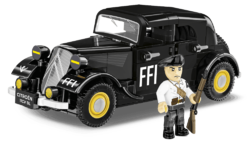Kit of the model of the civilian car CITROËN Traction 11CV BL in the service of the French Resistance. This 1:35 scale model is painted in black with French Resistance symbols on the sides. The front doors of the car open in the opposite direction as the real car. Included is a figure of French General Charles Delestraint and a figure of a Free French soldier armed with a rifle. The assembled model can be placed on a stand with a description included in package. The model is produced under the official license of Automobiles CITROËN.
Show more
100 %
(1 Ranking)
490 Kč
pcs
Add to Cart
In stock - ready to ship (5 pcs)
| List Number: | COBI-2265 |
| EAN: | 5902251022655 |
| Warranty: | 24 months |
| Manufacturer: | COBI |
| Price excluding VAT: | 405,28 Kč |
Description
Parametres
Files and Links3
Discussion
Reviews


You can see higher resolution images in the Files and links section.

You know that:
- In 1933, the development of the car was undertaken by the designer, sculptor, artist F. Bertoni and racing driver A. Lefébvre, whose collaboration resulted in an absolutely revolutionary car that was simply unrivalled at the time of its creation.
- Self-supporting construction, independent front-wheel suspension with torsion bars, the Citroen was a first.
- The design work on the first A7 series cars took a long time and André Citroën was running out of money, so he was forced to bring the car to market early, which resulted in a high failure rate in the first series.
- The Avant actually cost A. Citroën his life when he was forced to lay off several thousand employees and sell shares to tyre tycoon E. Michelin.
- Exhausted and broken, A. Citroën died in July 1935.
- At first, the public distrusted the technical innovations, and the carmaker had to demonstrate over and over again at numerous public events that Citröen cars were safe.
- In front of film crews, Citroen threw a car off an 8 metre cliff to prove that the self-supporting body was safe.
- There were two body styles on offer, the smaller BL and the almost 5m B.
- The 11CV was also used as a command vehicle by French General Charles Delestraint during the Battle of France.
- After the occupation of France, Ch. Delestraint became a major figure in the French Resistance.
Technical parameters:
- dimensions length 4,38 m, width 1,76 m, height 1,54 m
- weight 1070 kg
- power unit 4-cylinder 1 911 cc R4 petrol engine with an output of 41,2 kW
- maximum speed 120 km/h
- range approx. 450 km
- front-wheel drive
- number of speeds 3 forward and 1 reverse
- fuel tank 50 l
- number of seats 5
Instructions for assembly
| Version (series) | 01/2022 |
|---|---|
| Dimensions after assembly | 15 x 5,5 x 6 cm |
| Scale | 1:35 |
| Number of figurines | 2 pcs |
| Box dimensions | 27,5 x 20 x 6 cm |
| Number of pieces | 300 pcs |
| Package weight | 365 g |
| Recommended age | 8+ |
| Contains luminous blocks | No |
| Material | Plastic |
| Collection | World War II |
| Compatible with other brand of kits | Yes |
Discussion is empty.
There is no review for product yet
Related Items
Last viewed products
You might be interested






































































































